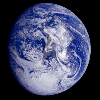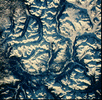 Earth
Earth
Planet Profile
Mass (kg)............................................5.98 x 10^24
Diameter (km)........................................12756
Mean density (kg/m^3) ...............................5520
Escape velocity (m/sec)..............................11200
Average distance from Sun (AU).......................1
Rotation period (length of day in Earth hours).......23.93
Revolution period (length of year in Earth days).....365.26
Obliquity (tilt of axis in degrees)..................23.4
Orbit inclination (degrees)..........................0
Orbit eccentricity (deviation from circular).........0.017
Mean surface temperature (K).........................281
Maximum surface temperature (K)......................310
Minimum surface temperature (K)......................260
Visual geometric albedo (reflectivity)...............0.39
Highest point on surface.............................Mount Everest
(over 8 km above sea-level)
Atmospheric components...............................78% nitrogen,
21% oxygen,
1% argon
Surface materials....................................basaltic and
granitic rock and
altered materials
 Earth in Color
Earth in Color
South America appears near the center of this view
of Earth. The white, sunlit continent of Antarctica lies near the bottom
of the globe. Picturesque weather fronts are visible in the South Atlantic,
lower right. This image was taken at about 14:10 UTC on December 11, 1990,
when Galileo was 2 million km (1.3 million mi) from Earth.
 Antarctica
Antarctica
Part of Antarctica is captured in this mosaic of
11 Galileo images. The mosaic spans about 1600 km (992 mi) across the south
polar latitudes of our planet. This part of Antarctica lies south of South
America. At lower left, the dark blue Ross Sea is visible, bounded by the
Ross Ice Shelf on the right. The Amundsen Sea is just visible at the top
and center of the image.
 Australia
Australia
Simpson Desert, 451 km (280 mi) wide by 547 km (340
mi) long, lies southeast of Alice Springs. At lower left is Lake Eyre,
a salt lake below sea level. Its water level changes dramatically throughout
the seasons. At the time this image was taken the lake was nearly dry.
At lower right is the greenish Lake Blanche. Fields of linear sand dunes
stretch north and east of Lake Eyre, shaped by prevailing winds from the
south. The various sources and age of the sand can be determined by their
color.
 Mount Etna,
Sicily
Mount Etna,
Sicily
This active stratovolcano on the east coast of Sicily
is almost always venting steam into the atmosphere. Stratovolcanoes form
as alternating layers of volcanic ash and lava flows come from their central
vents and cool to form rock. During one eruption in 1969 fragments up to
1 meter (about 3 feet) across were ejected from the volcano. This image
was acquired by Space Shuttle astronauts, and is slightly enhanced to bring
out details in the volcano. Mount Etna is over 3000 meters (10,000 feet)
high, making it the highest peak in Italy south of the Alps.
 Cassiar
Mountains
Cassiar
Mountains
This part of the Rocky Mountain Range in the Yukon
Territory of Canada is an excellent example of mountains on Earth. This
space shuttle image was taken when the sun was low on the horizon; the
sharp shadows on the snow-covered peaks show how rough and uneven the area
is. These mountains are so remote and rugged that ground surveys of the
area are very expensive. Due to remote-sensing techniques developed for
planetary exploration, many such areas can now be observed and studied
from space at much less cost and effort.
 Strait
of Gibraltar
Strait
of Gibraltar
This space shuttle view of the Atlantic Ocean and
Mediterranean Sea illustrates an important feature of Earth-a seacoast.
Earth is the only planet with borders of land adjacent to bodies of water
because it is the only planet where liquid water is stable at the surface.
Seas are important because water has been the catalyst for the development
of life on our planet. The Strait of Gibraltar is the border between Africa
and Europe. In Spain, to the left, the small spike of land is the Rock
of Gibraltar; Africa is on the right side of the image.
 Mississippi
River
Mississippi
River
This view over St. Louis, Missouri, taken in June
1991, shows the Mississippi just left of center. The Mississippi-Missouri
river system is the third longest in the world--shorter only than the Nile
in Africa and the Amazon in South America. This river system is a meandering
river system, where flooding is often responsible for changing the location
of channels and leaving behind old riverbeds known as "meander scars."
These scars are visible in the river bottom land between the cliffs on
either side of the river.
 Grand
Canyon
Grand
Canyon
This space shuttle image of the Colorado River in
Arizona captures the Grand Canyon. The canyon is 30 km (18 miles) across
at its widest point and 1.6 km (1 mile) deep at rock bottom. It is 446
km (277 miles) long and covers an area that is over 5000 square km (about
2000 square miles). The Grand Canyon was created by the erosional action
of the Colorado River on the surface as this region has continued to rise
high above sea level over the last several million years.
 Volcano Views
Volcano Views
These side-by-side images of the same volcanic eruption
show the differences between optical imaging and radar imaging. On the
left is a photograph taken by Space Shuttle astronauts as the Shuttle Endeavor
passed over the eruption of Kliuchevskoi volcano in Kamchatka, Russia.
On the right is the radar image acquired several days earlier by the SIR-C/X-SAR
radar instrument. In the photograph, the ash plume is emerging from a vent
on the north flank of Kliuchevskoi. In this view, the volcano is partially
hidden by the ash plume and its shadow. The radar image shows how radar
can see through the ash and smoke to reveal the contours of the land underneath.
 Wadi Kufra, Libya
Wadi Kufra, Libya
Radar's ability to penetrate dry sand cover produced
the discovery in this image: a previously unknown branch of an ancient
river, buried for thousands of years under the sands of the Sahara Desert.
This area is near the Kufra Oasis in southeast Libya. The image was acquired
by the SIR-C/X-SAR imaging radar when it flew aboard the space shuttle
Endeavour in October, 1994. This image reveals a system of old, now inactive
stream valleys which, during periods of wetter climate, carried running
water northward across the Sahara. The region now receives only a few millimeters
of rainfall per year, and the ancient river valleys are mostly buried by
windblown sand.
 The Moon from Space
The Moon from Space
These pictures of the moon were taken by the Galileo
spacecraft. The picture at left shows the OrientaleBasin, with a small,
dark mare in its center. The picture on the right shows the globe of the
moon rotated, putting Orientale on the western limb. The dark Oceanus Procellarum
is in the upper center, with Mare Imbrium above it, and the smaller, circular
Mare Humorum below.
 Apollo 17 Landing Site
Apollo 17 Landing Site
Apollo 17 astronauts explored this area of the moon
in December 1972. The North Massif is located at the top of the image,
and the South Massif is located at the bottom on the left. The North Massif
is more than 2 km high (1.2 mi). The terrain between the mountains is peppered
with impact craters, the largest of which is about 1 km (0.6 mi) in diameter.
A bright scarp, named the Lee-Lincoln scarp, winds around the left side
of the North Massif and down through the cratered field.
 Plum Crater
Plum Crater
An Apollo 16 astronaut stands near the rim of Plum
Crater (30m, or over 200 yards, in diameter) on the moon. Although Earth
has experienced many meteorite impacts throughout its history, the action
of wind and water quickly erases the resulting craters. Because these forces
don't exist on the moon, the only way evidence of impact craters can be
removed is by being destroyed by later impacts. However, this is not a
very efficient process so craters last a long time on the moon's surface.
 Hadley
from Space
Hadley
from Space
Molten basaltic lava cut this channel, known as Hadley
Rille, through the surface of the moon. The channel winds along the base
of the Apennine Front, one of the sites explored by the Apollo 15 astronauts.
It measures 1500m (nearly 1 mi) wide, 400m (433 yards) deep, and 100 km
(60 miles) long. The walls of the channel are very steep, with slope angles
of 25 to 30 degrees.
 Hadley
on the Surface
Hadley
on the Surface
An Apollo 15 astronaut looks down on the Hadley Rille,
nearly 1.5 km (.9 mi) across at its widest point. The astronauts observed
layering in the lava flows in the wall on the opposite side of the rille,
indicating that multiple lava flows formed the bedrock in this region.
 Taurus-Littrow
Taurus-Littrow
These highland massifs in the Taurus-Littrow region
of the moon are mountains composed of highland material--the oldest type
of rock on the moon. Between the mountains are narrow valleys where mare
basalt once flowed. This image was recorded from lunar orbit by the Apollo
17 mission to the moon. The Apollo landing site is in the upper right quadrant
of the image.
 North
Massif
North
Massif
Apollo 17 astronaut Harrison "Jack" Schmitt is here
collecting a sample from the North Massif site, Taurus-Littrow.
 Highland
Anorthosite
Highland
Anorthosite
When the moon first formed it probably had a surface
composed mostly of feldspar-richigneous rocks. This rock type still exists
today and makes up the lunar highlands, which is the lighter-colored part
of the moon visible from Earth. This 4.4-billion-year-old rock sample is
an anorthosite collected from the lunar highlands of the moon by Apollo
16 astronauts.
 Mare
Basalt
Mare
Basalt
This igneous rock was collected from one of the darker
areas on the moon known as mare. The mare formed billions of years ago.
Large meteorites impacted the surface of the moon and broke up the crust.
Later lavas formed by melting of rock within the moon due to the decay
of radioactive elements. The broken crust under the big impact craters
allowed the lava to come to the surface. Over time the craters came to
be filled with lava flows. This basalt sample, estimated to be 3.7 billion
years old, was collected by Apollo 17 astronauts.
 Highland
Breccia
Highland
Breccia
On Earth, the surface is eroded by the action of
water and wind. The most important process for altering the surface of
the moon, however, is that of meteorites impacting upon and breaking up
the surface. This lunar sample is a rock type named breccia. On the moon
a breccia is made when meteorites break up the surface and the pieces are
welded together by the heat and pressure of impact processes. This breccia
was collected by Apollo 16 astronauts and is 3.9 billion years old.
 This page was taken from Planets Home Page
This page was taken from Planets Home Page
 Earth
Earth Earth
Earth Earth in Color
Earth in Color Antarctica
Antarctica Cassiar
Mountains
Cassiar
Mountains Apollo 17 Landing Site
Apollo 17 Landing Site Mare
Basalt
Mare
Basalt Highland
Breccia
Highland
Breccia